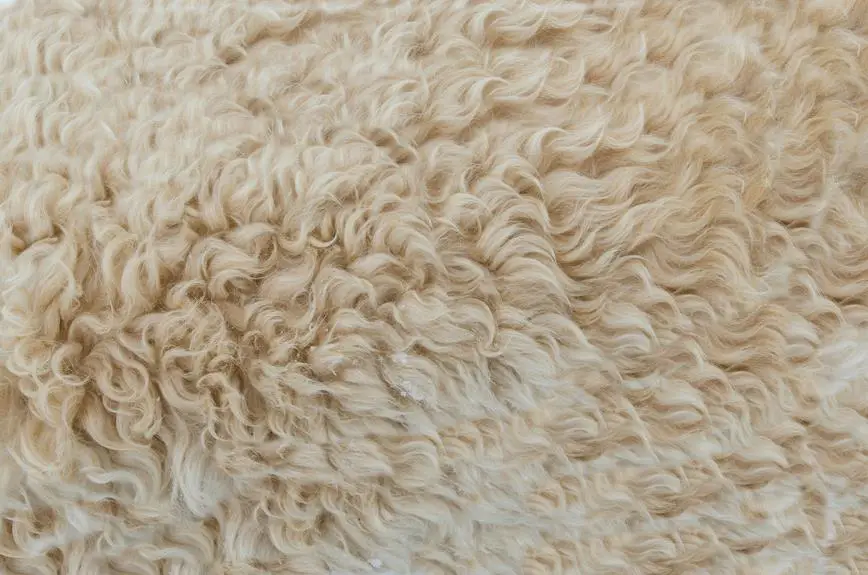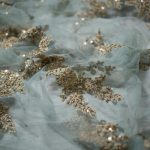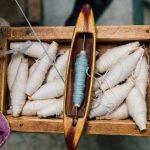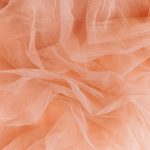When you're considering gossamer and organza, the structural differences can greatly influence your design choices. Gossamer's airy weave lends itself to soft draping and romantic silhouettes, while organza's tighter construction offers crisp lines and form. Each fabric brings its own unique characteristics to the table, impacting everything from texture to durability. As you explore these distinctions, you might find yourself questioning which fabric serves your creative vision best, especially when it comes to specific applications in fashion design and decor. What other factors should you weigh in this decision?
Table of Contents
Overview of Gossamer Fabric
Have you ever wondered what makes gossamer fabric so unique and ethereal? This delicate textile captures attention with its lightness and transparency. Often woven from silk, gossamer boasts an almost sheer quality that allows light to filter through, creating a dreamy effect. When you touch it, you'll notice the softness, which sets it apart from coarser materials.
Gossamer is typically very thin, and its construction involves fine threads that contribute to its airy feel. This fabric doesn't just look beautiful; it drapes gracefully, making it a favorite in fashion and decoration. When you see gossamer in action, whether it's flowing in a dress or floating as a curtain, you can't help but appreciate its artistic versatility.
What's fascinating about gossamer is its ability to transform any garment or setting into something enchanting. Your imagination may run wild with the possibilities—wedding gowns, evening wear, or whimsical home accents. The lightweight nature allows for layering without bulk, enhancing its allure. Gossamer isn't just fabric; it's a statement of elegance and ephemeral beauty, inviting you to explore its endless possibilities.
Overview of Organza Fabric
When you're exploring organza fabric, understanding its composition is essential.
You'll notice significant differences in weight and sheerness compared to gossamer, which can influence your choice for various applications.
Let's break down these key points so you can see how organza fits into your projects.
Fabric Composition Explained
Organza, a sheer fabric often made from silk or nylon, combines a lightweight feel with a crisp texture, making it popular for bridal wear and evening gowns. This unique composition gives organza its distinctive qualities, allowing it to hold shape and create volume in various garments. When you touch organza, you'll notice how smooth and delicate it feels against your skin.
The silk varieties of organza have a luxurious appearance due to their natural fibers, reflecting light beautifully and adding a touch of elegance. Nylon-organza blends, on the other hand, offer increased durability and resilience while retaining that signature crispness. This durability makes nylon organza an excellent choice for decorations, such as wedding decorations and crafts, where longevity is important.
In terms of care, organza is typically lightweight and may require gentle handling. Dry cleaning is often recommended, as washing can distort its shape.
When choosing organza, consider the fiber content that best suits your project, whether you prioritize elegance, durability, or ease of care. Overall, organza's composition makes it a versatile fabric that can elevate your fashion projects.
Weight and Sheerness Differences
One key aspect to consider about organza is its lightweight nature, which typically ranges from 30 to 50 grams per square meter, making it one of the most delicate fabrics available.
This lightness contributes to organza's sheer quality, giving it a transparent appearance that can enhance the visual appeal of garments and decor. You'll notice that when you hold organza, it feels airy and flowing, allowing light to pass through almost effortlessly.
In contrast, gossamer, while also lightweight, usually boasts a slightly heavier feel, typically falling above organza in weight. This difference in weight can influence how each fabric drapes and behaves.
Organza, with its crisp texture, holds shapes well, providing structure to designs, whereas gossamer tends to flow more fluidly.
When it comes to sheer qualities, both fabrics are transparent, but organza often offers a more pronounced crispness, which can add definition to edges and layers in a piece.
Understanding these weight and sheerness differences can help you select the right fabric for your needs, whether you're designing apparel or creating elegant home accents.
Common Uses and Applications
Brides often choose organza for wedding dresses and veils due to its elegant drape and translucent quality, creating a delicate and ethereal appearance. But organza isn't just for weddings; it's highly versatile and finds its way into various applications.
Here are some common uses for organza fabric:
- Evening Gowns: You can find organza in formal and evening wear, adding a touch of sophistication.
- Home Décor: Many use organza for curtains and overlays, giving rooms a light, airy feel while filtering light beautifully.
- Crafting: You can easily incorporate organza into DIY projects, such as making gift bags, bows, and embellishments, thanks to its stiffness and ability to hold shape.
- Party Decorations: Organza is perfect for creating table runners, backdrops, and chair sashes, enhancing the visual appeal of any celebration.
With its unique qualities, organza brings beauty and functionality to many facets of life, from fashion to home décor and beyond.
Whether you're planning a wedding or redecorating, consider the enchanting allure of organza.
Composition Differences
Gossamer and organza differ primarily in their fiber composition, affecting their texture and overall appearance.
Gossamer typically consists of fine, lightweight fibers, often made from silk or nylon. This choice of fibers contributes to its ethereal quality and delicate nature. On the other hand, organza is usually crafted from silk, polyester, or nylon but incorporates a more structured weave, giving it a stiffer feel. The silk in organza enhances its luxurious look, while polyester versions offer durability at a lower cost.
When you encounter these fabrics, you'll notice how gossamer tends to drape softly, making it ideal for soft overlays and delicate garments. Organza, with its crisper structure, is perfect for adding volume to skirts and accents in formal wear.
The differences in fiber composition also result in varied maintenance needs; gossamer can require more delicate handling due to its fragility, whereas organza is more resistant to wear.
Understanding these composition differences allows you to make informed choices when selecting materials for your creative projects, ensuring the right texture and style for your intended use.
Weave and Texture Comparison
When you compare gossamer and organza, their weaves reveal important differences in texture and appearance.
Gossamer often features a looser, more airy weave, while organza has a tighter, crisp structure.
This unique construction affects not just how each fabric feels, but also how it looks in various applications.
Weave Types and Patterns
Different weave types and patterns create distinctive textures that set gossamer and organza apart in both appearance and feel. When you explore these fabrics, you'll notice several key differences in their weave structures.
Here's what makes them unique:
- Gossamer Weave: Typically features a looser, open weave pattern that results in a lightweight and airy texture, enhancing its delicate feel.
- Organza Weave: Generally employs a more structured, tighter weave that gives it a crisp, stiffer quality, making it ideal for structured designs.
- Variability: Gossamer can vary in weave styles, offering subtle differences in visual texture, while organza tends to have a more consistent weave across the fabric.
- Sheen and Light Play: The weave pattern in both fabrics influences their sheen. Gossamer often reflects light softly, whereas organza can create a more pronounced shine due to its tighter weave.
Understanding these weave types helps you appreciate how they impact shape and structure, guiding your choice depending on your fabric needs.
Whether you want something flowing or crisp, the right weave can make all the difference!
Surface Feel and Appearance
The surface feel and appearance of gossamer and organza distinctly highlight their unique textures, making each fabric suitable for different aesthetic and functional purposes.
When you touch gossamer, you'll notice its almost ethereal softness; it has a delicate, lightweight feel that drapes beautifully. This airy texture lends itself well to garments that need a light and flowing effect, perfect for romantic dresses or whimsical layers.
On the other hand, organza has a crisper texture with a slightly stiffer hand. This fabric offers more structure, making it an excellent choice for formal wear, bridal gowns, or decor where you want a bit of volume. Although both fabrics can appear sheer, organza's crispness allows it to maintain its shape better, giving you clean lines.
Visually, gossamer tends to have a subtle sheen, enhancing its delicate character, while organza shines more brightly, which can elevate its refined appearance.
Ultimately, whether you're opting for the soft elegance of gossamer or the structured sophistication of organza, understanding these differences will help you make the best choice for your design needs.
Durability and Strength
Gossamer's delicate nature often contrasts with organza's sturdier composition, showcasing how each fabric excels in its own realm of durability and strength.
While gossamer is lightweight and ethereal, it's not the best choice if you need a fabric that can withstand wear and tear. Organza, on the other hand, possesses more resilience, making it suitable for projects that require some toughness.
Here's a quick rundown of their durability and strength characteristics:
- Gossamer: Best for applications where a light, airy feel is desired but may tear easily if subjected to stress.
- Organza: More robust, able to endure pressure and pull without easily fraying.
- Weight Consideration: Gossamer is lighter, contributing to its fragility. Organza's heavier structure gives it added strength.
- Maintenance: Gossamer often requires more careful handling and specialized cleaning, while organza can generally withstand more typical laundering practices.
Application and Use Cases
When choosing between gossamer and organza for your project, consider their distinct uses that cater to various aesthetic and practical needs.
Gossamer, with its lightweight and sheer qualities, is perfect for delicate garments or layering. You'll often find it used in ethereal wedding dresses, soft evening wear, or elegant accessories like shawls. Gossamer creates an airy feel, making it ideal for designs aiming for a romantic or whimsical look.
On the other hand, organza boasts a slightly stiffer and more structured form, making it a favorite for formal occasions. It's commonly used in evening gowns, cocktail dresses, and even home décor items like curtains and table runners. The crisp texture of organza holds its shape beautifully, allowing for dramatic silhouettes and stunning details like ruffles or bows.
In crafting or decor, gossamer can bring a lightness that enhances floral arrangements or party decorations, while organza adds sophistication and volume.
Ultimately, your choice between the two fabrics will influence the visual impact and functionality of your creation, so think carefully about what fits your vision best.
Frequently Asked Questions
Can Gossamer Be Dyed Easily Compared to Organza?
You'll find that gossamer can be dyed more easily than organza due to its fine fibers. The dye penetrates quickly, giving vibrant results, while organza's coarser texture might require more effort and time.
How Does the Cost of Gossamer Compare to Organza?
When considering costs, gossamer generally tends to be less expensive than organza. You'll find that this affordability makes gossamer a popular choice for various projects, especially when you're on a budget and need lightweight fabric.
Is Gossamer More Environmentally Friendly Than Organza?
You'll find gossamer tends to be more environmentally friendly, as it often comes from natural fibers and uses less energy during production. Organza, typically made from synthetic fibers, can have a heavier environmental impact.
Which Fabric Is More Suitable for Outdoor Use?
When choosing fabric for outdoor use, consider durability and weather resistance. Gossamer's lightweight nature might not hold up against harsh conditions, whereas organza's sturdiness makes it a better option for outdoor applications.
Can Gossamer and Organza Be Blended With Other Fabrics?
Yes, you can definitely blend gossamer and organza with other fabrics. Mixing them with cotton or silk creates unique textures, enhancing the overall look and feel of your project while retaining their lightweight qualities.
- Ivory Chamois Fabric: Style and Application Guide - June 22, 2025
- Winterfleece Micro Chamois White Fabric: Uses and Benefits - June 22, 2025
- Clarksville Chamois Fabric: A Detailed Overview - June 22, 2025







